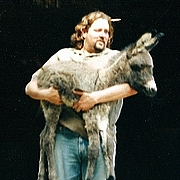Bright orange hairy brush parasite
-
simonov

- Posts: 1102
- Joined: Tue Nov 27, 2007 5:44 pm
- Location: Reno, NV
Anyone know what this stuff is? It's growing on the chaparral in Crystal Cove State Park:
Nunc est bibendum
-
Elwood

- Posts: 622
- Joined: Fri Aug 15, 2008 5:23 pm
It's called Dodder, of the family cuscuta. It's a parasitic plant that chokes out its host. It's also know as "witches hair".
-
norma r

- Posts: 707
- Joined: Thu Nov 06, 2008 4:22 pm
I hate Dodder. It's everywhere! I have even seen it in Death Valley. 
-
Zach

- Posts: 522
- Joined: Sun Jan 04, 2009 4:25 pm
is it an invasive species? if so where'd it come from?
-
simonov

- Posts: 1102
- Joined: Tue Nov 27, 2007 5:44 pm
- Location: Reno, NV
Thanks, I can update my pic caption.
Nunc est bibendum
-
Rumpled
- Posts: 271
- Joined: Mon Feb 25, 2008 10:57 pm
I've heard that this is actually a "smart" parasite and doesn't kill the host.
Not sure if it is true, but it would make sense for overall parasite survival.
Not sure if it is true, but it would make sense for overall parasite survival.
-
jimqpublic
- Posts: 58
- Joined: Mon Dec 15, 2008 10:05 am
Yes, Dodder is invasive. It came from someone's shoes, or vehicle, or maybe a bird. The seeds can be in animal feed such as hay and pass right through a horse.Zach wrote:is it an invasive species? if so where'd it come from?
Obviously it's tough because it's often in the desert in small patches near roads.
http://www.colostate.edu/Depts/CoopExt/TRA/dodder.html
-
Rumpled
- Posts: 271
- Joined: Mon Feb 25, 2008 10:57 pm
I'm not sure if the dodder mentioned here is invasive or not.
This page
http://www.ipm.ucdavis.edu/PMG/WEEDS/dodder.html
says that we have native species in most communities - making it native and nonivsive - just a local parasite.
Here's another listing natives and nonnatives
http://www.calflora.org/cgi-bin/species ... 1272063791
Most seem to be native and what I've seen and is pic'd by Simonov looks most like desert dodder, but not exactly to me.
This page
http://www.ipm.ucdavis.edu/PMG/WEEDS/dodder.html
says that we have native species in most communities - making it native and nonivsive - just a local parasite.
Here's another listing natives and nonnatives
http://www.calflora.org/cgi-bin/species ... 1272063791
Most seem to be native and what I've seen and is pic'd by Simonov looks most like desert dodder, but not exactly to me.
-
PackerGreg

- Posts: 623
- Joined: Sat Sep 12, 2009 9:31 pm
Yes, our Dodder is native. It is typically seen in areas that are in decline. Many wild flowers and even some trees will thrive after a major disturbance such as, and in particular for the San Gabriels, fire. They don't have the competition for sunlight and nutrients that they did before the fire. But Dodder, being a parasite and needing a host, is not usually seen following a fire. As the ecosystem (i.e. Chaparral) nears its "carrying capacity" the inhabitants become old and weakened, thus making it easier for the parasite to take hold. If you see Chaparral loaded with Dodder, it probably needs to burn.
-
simonov

- Posts: 1102
- Joined: Tue Nov 27, 2007 5:44 pm
- Location: Reno, NV
No one is going to let Crystal Cove, which is adjacent to Newport Coast, burn any time soon.PackerGreg wrote:If you see Chaparral loaded with Dodder, it probably needs to burn.
Nunc est bibendum
-
PackerGreg

- Posts: 623
- Joined: Sat Sep 12, 2009 9:31 pm
@ simonov: I simply made a factual statement about California natural history. It was not intended to be political. One must heed, however, the lessons of disastrous fires of recent past. Fire doesn't know from the Newport Coast or the back woods, and if the residents of Crystal Cove are noting an epidemic of Dodder, they ought to reduce the aging fuel load somehow. If, for some reason, a controlled burn is out of the question, then a FireSafe Council ought to be formed; thereby accessing much grant money to perform a successful fire clearance.
I'm just saying that an abundance of Dodder could be a bad sign. And about the FSC, I'm not up for handing out federal funds willy-nilly, but the cost of a chipper and a hand crew in training is a lot cheaper than fighting a fire, and they'd probably have better results.
I'm just saying that an abundance of Dodder could be a bad sign. And about the FSC, I'm not up for handing out federal funds willy-nilly, but the cost of a chipper and a hand crew in training is a lot cheaper than fighting a fire, and they'd probably have better results.
